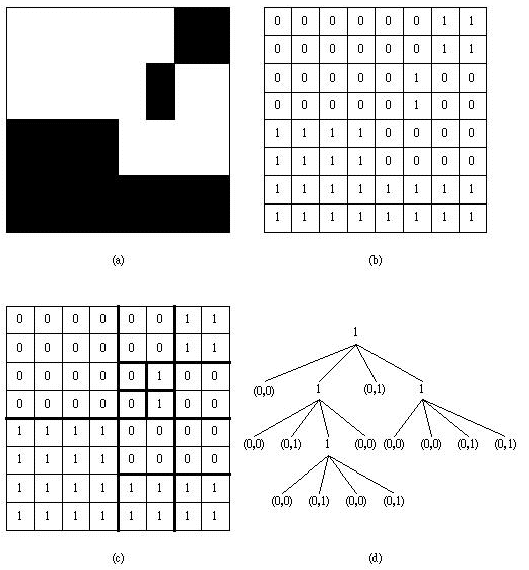1932 Quad Trees
题目描述

Figure 2: A binary image (a), its array representation (b), its quad tree partition (c), and its quad tree representation (d).
Instead of storing the binary image of Figure 2(a), we only need to store the quad tree in the form as Figure 2(d) which is encoded from Figure 2(c). In Figure 2(d), each node represents an array of Figure 2(c) in which the root node represents the original array. If the value of a node in the tree is 1, then it means that its corresponding array needs to be decomposed into four smaller arrays. Otherwise, a node will have a pair of values and the first one is 0. It means that its corresponding array is not necessary to decompose any more. In this case, the second value is 0 (respectively, 1) to indicate that all the entries in the array are 0 (respectively, 1). Thus, we only need to store the tree of Figure 2(d) to replace storing the binary image of Figure 2(a). The way to store the tree of Figure 2(d) can be represented by the following code:
(1)(0,0)(1)(0,1)(1)(0,0)(0,1)(1)(0,0)(0,0)(0,0)(0,1)(0,1)(0,0)(0,1)(0,0)(0,1).
This code is just to list the values of the nodes from the root to leaves and from left to right in each level. Deleting the parentheses and commas, we can obtain a binary number 100101100011000000010100010001 which is equal to 258C0511 in hexadecimal. You are asked to design a program for finding the resulting hexadecimal value for each given image.
输入格式:
输出格式:
3 2 0 0 0 0 4 0 0 1 1 0 0 1 1 1 1 0 0 1 1 0 0 8 0 0 0 0 0 0 1 1 0 0 0 0 0 0 1 1 0 0 0 0 0 1 0 0 0 0 0 0 0 1 0 0 1 1 1 1 0 0 0 0 1 1 1 1 0 0 0 0 1 1 1 1 1 1 1 1 1 1 1 1 1 1 1 1
0 114 258C0511
